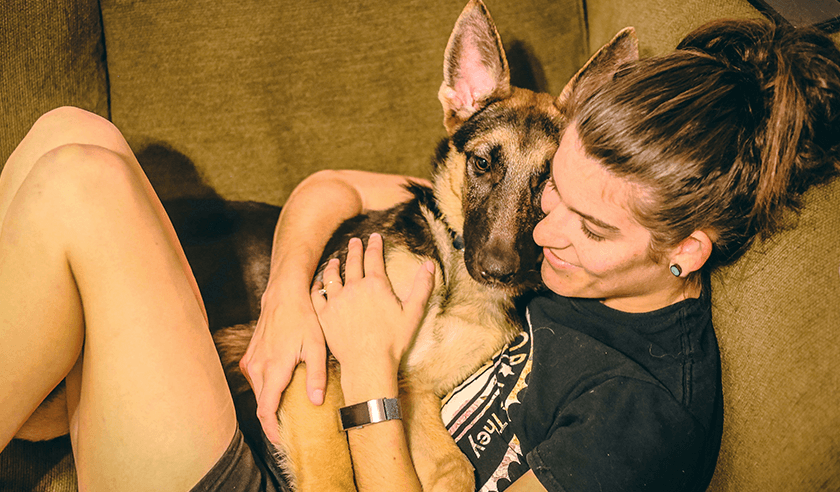Dogs have been helping humans for centuries as reliable companions. In some cases, that help comes specifically in the form of physical or emotional support. You've probably heard of service dogs, therapy dogs, and emotional support dogs ‐ and you may even think those are three names for the same thing. But there are significant differences between the jobs that each dog performs. If you're thinking about getting a service dog, training your dog for therapy work, or just want to learn a little more about the amazing things these dogs can do, read on. There are key distinctions for each working role, including the support they provide, the type of training they receive, and where they can accompany their handler.
What Is a Service Dog?
According to the Americans with Disabilities Act (ADA), service animals are defined as “a dog that is individually trained to do work or perform tasks for a person with a disability[1].” Those tasks must directly relate to the person's disability, such as a guide dog for someone who is blind.

It is incredible what service dogs can be trained to do. Diabetic alert dogs detect changes in blood sugar levels and alert their handler. Mobility service dogs are trained to provide physical support for handlers who need help with balance or movement. Service dogs also help those suffering from mental illness, having been trained to signal that it's time to take medication or to provide stress relief for those who suffer from post‐traumatic stress disorder.
Where Are Service Dogs Allowed?
Service dogs can accompany their handler in any public area, such as restaurants, classrooms, and grocery stores. The access of service dogs to public areas is legally protected by the Americans with Disabilities Act (ADA), the Air Carrier Access Act, the Fair Housing Act, and the Federal Rehabilitation Act. The only places service dogs are not allowed is where their presence might contaminate a sterile environment, such as a hospital operating room or a laboratory.
Because they're allowed in so many places, service dogs are expected to complete intensive training. They must be able to stay completely focused on their handler while working and perform their essential duty to keep their handler safe, no matter the distractions around them. That's why it is so important that people don't pet or interact with working service dogs — it could be life‐threatening for their handler.
How Are Service Dogs Trained?
Not every dog is cut out for the intensive work of being a service dog. There are many programs, such as Guide Dogs for the Blind, that focus on responsibly breeding and training service dogs for roles. Programs like these have been able to identify beneficial genetic traits and profiles for their service dogs — but even careful breeding programs have dogs that simply don't make the cut. It's a demanding job, and those who don't graduate as service dogs are often trained in other working roles as therapy or emotional support dogs or placed as pets. Beyond these types of breeding programs, many service dogs are adopted from rescues or shelters as puppies and complete the intensive training one‐on‐one with their handler.
To prevent discrimination against those with disabilities, there is no national certification required for service dogs. However, when asked, a service dog handler must be able to explain the work or task their service dog is trained to perform. This helps to minimize abuse of the ADA by people claiming their dog is a service dog for less than legitimate reasons. Service dogs must also have proof of current vaccines and negative parasite tests.
What Is a Therapy Dog?
A therapy dog's job is to provide comfort and support, both psychologically and through physical presence or touch. In contrast to service dogs, the therapy dog's work is less about helping the handler accomplish a task and more about providing support and enabling a positive interaction with other people. They complete advanced training and register with a respective organization. They can then volunteer with their owner to visit people who may benefit from that comfort and support, improving the lives of children in schools, patients in hospitals, senior citizens in assisted living or nursing homes, and others. Popular programs include Reading with Rover, where a dog sits and listens to a child read, improving the child's confidence and providing a judgment‐free audience. Therapy dogs have even been used in courthouses where a witness might feel scared about testifying, as well as to provide comfort for first responders in disaster zones.
A therapy dog is different from a service dog in that they are not trained to specifically assist their handler with a task related to a disability. While it's inappropriate to interact with a working service dog without explicit permission from the handler, it's typically encouraged to interact with therapy dogs when they are working. If there is any question about a working dog's role, always ask the handler and seek permission before interacting with the dog.
Where Are Therapy Dogs Allowed?
Therapy dogs do not have the same access privileges as service dogs. However, when “on the job” they are allowed in many places where pet dogs are not permitted. These visits must usually be pre‐approved and scheduled with the location being visited, such as a hospital or nursing home. Therapy dogs must also have proof of current vaccines and negative parasite tests.
How Are Therapy Dogs Trained?
To become a therapy dog, a dog must be well socialized and have a specific temperament. They should be friendly, enjoy being handled, and able to remain calm in distracting environments. Therapy dogs‐in‐training learn specific behaviors that help them better interact with the people around them, from holding a down‐stay command, to jumping up on a bed or chair when asked. The AKC's Canine Good Citizen test is often the first level of training required to move into therapy work. Then the dog must be assessed by a therapy dog organization, based on the desired category of therapy work they intend to do. Upon successful completion of an assessment, the owner and their therapy dog receive certification. Many dogs, no matter their breed or size, do well and enjoy their work in this area.
What Is an Emotional Support Dog?
Emotional support dogs are quite different than service and therapy dogs. They provide comfort and companionship for their owners but are not required to undergo specific training. For this reason, they are not allowed access to the same public and private places as service or therapy dogs. However, if a person living in no‐pet housing needs an emotional support dog, a physician might request a special allowance by writing a letter stating that the person's dog is serving as an emotional support dog. Unfortunately, claiming a dog as an emotional support animal has been abused by some people in recent years in order to obtain access to in‐cabin air travel, among other places. In December 2020, the US Department of Transportation revised the Air Carrier Access Act with a final rule to no longer allow emotional support dogs in plane passenger cabins.
Dogs never stop surprising us with their abilities and dedication to humans. Service, therapy, and emotional support dogs do amazing work, as do their trainers and handlers. If you believe a service or emotional support dog might be helpful to you, talk with your physician or mental health professional to determine what kind of support you need. If you're interested in volunteering with your dog for therapy work, look into getting certified.
ZPC-01085R1
- Americans with Disabilities Act, Disability Rights Section. U.S. Department of Justice Civil Rights Division. https://www.ada.gov/service_animals_2010.htm. Accessed February 11, 2021.



.jpg)

